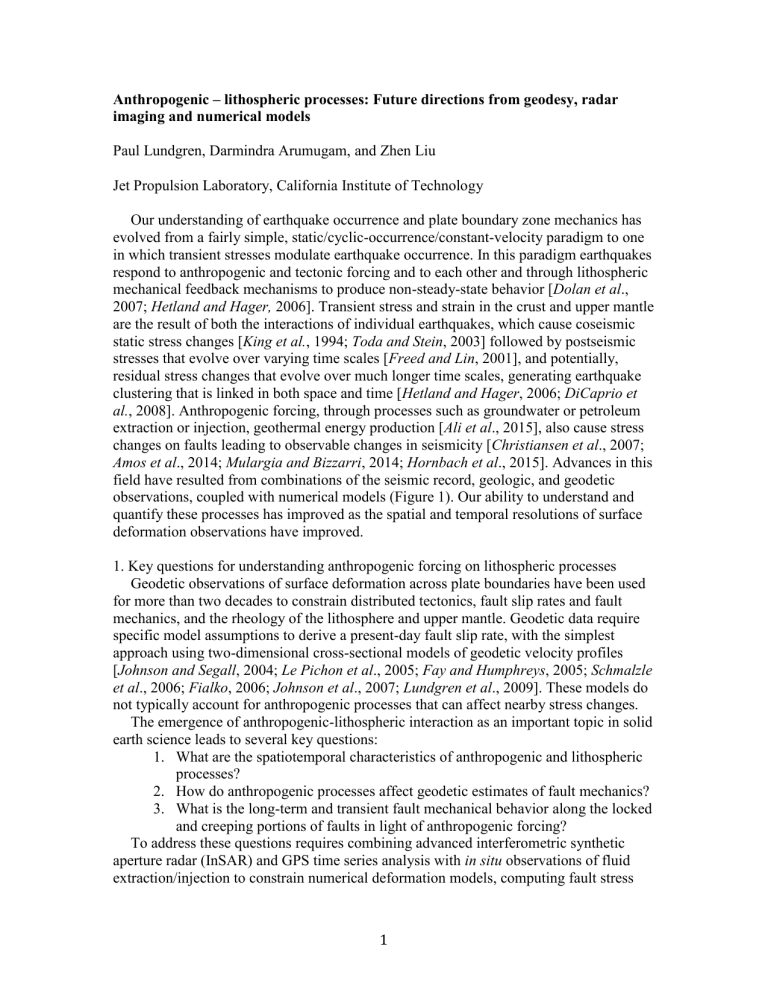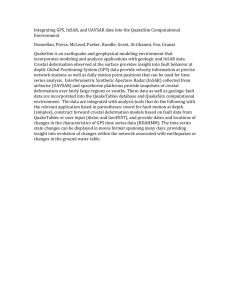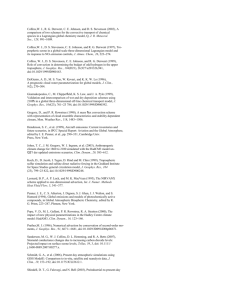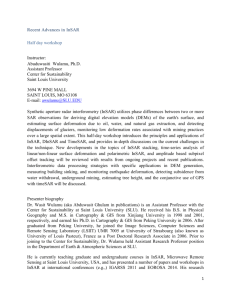Anthropogenic – lithospheric processes: Future directions from

Anthropogenic – lithospheric processes: Future directions from geodesy, radar imaging and numerical models
Paul Lundgren, Darmindra Arumugam, and Zhen Liu
Jet Propulsion Laboratory, California Institute of Technology
Our understanding of earthquake occurrence and plate boundary zone mechanics has evolved from a fairly simple, static/cyclic-occurrence/constant-velocity paradigm to one in which transient stresses modulate earthquake occurrence. In this paradigm earthquakes respond to anthropogenic and tectonic forcing and to each other and through lithospheric mechanical feedback mechanisms to produce non-steady-state behavior [ Dolan et al .,
2007; Hetland and Hager, 2006]. Transient stress and strain in the crust and upper mantle are the result of both the interactions of individual earthquakes, which cause coseismic static stress changes [ King et al.
, 1994; Toda and Stein , 2003] followed by postseismic stresses that evolve over varying time scales [ Freed and Lin , 2001], and potentially, residual stress changes that evolve over much longer time scales, generating earthquake clustering that is linked in both space and time [ Hetland and Hager , 2006; DiCaprio et al.
, 2008]. Anthropogenic forcing, through processes such as groundwater or petroleum extraction or injection, geothermal energy production [ Ali et al ., 2015], also cause stress changes on faults leading to observable changes in seismicity [ Christiansen et al ., 2007;
Amos et al ., 2014; Mulargia and Bizzarri , 2014; Hornbach et al ., 2015]. Advances in this field have resulted from combinations of the seismic record, geologic, and geodetic observations, coupled with numerical models (Figure 1). Our ability to understand and quantify these processes has improved as the spatial and temporal resolutions of surface deformation observations have improved.
1. Key questions for understanding anthropogenic forcing on lithospheric processes
Geodetic observations of surface deformation across plate boundaries have been used for more than two decades to constrain distributed tectonics, fault slip rates and fault mechanics, and the rheology of the lithosphere and upper mantle. Geodetic data require specific model assumptions to derive a present-day fault slip rate, with the simplest approach using two-dimensional cross-sectional models of geodetic velocity profiles
[ Johnson and Segall , 2004; Le Pichon et al ., 2005; Fay and Humphreys , 2005; Schmalzle et al ., 2006; Fialko , 2006; Johnson et al ., 2007; Lundgren et al ., 2009]. These models do not typically account for anthropogenic processes that can affect nearby stress changes.
The emergence of anthropogenic-lithospheric interaction as an important topic in solid earth science leads to several key questions:
1.
What are the spatiotemporal characteristics of anthropogenic and lithospheric processes?
2.
How do anthropogenic processes affect geodetic estimates of fault mechanics?
3.
What is the long-term and transient fault mechanical behavior along the locked and creeping portions of faults in light of anthropogenic forcing?
To address these questions requires combining advanced interferometric synthetic aperture radar (InSAR) and GPS time series analysis with in situ observations of fluid extraction/injection to constrain numerical deformation models, computing fault stress
1
changes, earthquake cycle slip rates, postseismic deformation, and time variations in seismicity. These processes are of global relevance, with California an ideal location for studying the spatiotemporal effects of long-term, seasonal, and intermittent forcing due to water and petroleum extraction, injection, and seasonal hydrological recharge.
Figure 1. Poroelastic simulation of the effects of groundwater pumping and unloading of the Central
Valley, CA, on the San Andreas fault, using finite element method (FEM) code Defmod [Ali, 2014] The unclamping stress across the upper 20 km of a fault (a) shown in the model (b) by the white dashed line. A detail of the aquifer (white box in (b)) is shown in (c). (d) A profile of the surface deformation.
2. Timeliness
2.1 InSAR
Recent advances in satellite InSAR, through higher temporal sampling from satellite constellations such as the X-band Italian COSMO-SkyMed, the German TerraSAR-X, Cband European Sentinel-1A/B (S1B not yet launched), L-band SAR missions such as the current Japanese ALOS-2, and the future Argentine SAOCOM tandem and NASA
NISAR missions will greatly improve the spatial and temporal coverage critical for global geodetic observations at spatiotemporal sampling that will provide critical geodetic constraints on time-varying anthropogenic processes.
Although geodesy has the ability to track spatial and temporal patterns of deformation from anthropogenic processes, it generally lacks resolution of the depth and volume of subsurface reservoirs.
2.2 Volume
Rayleigh-resonance (RR) radar imaging is a newly emerging method that may allow us to directly image magma and other fluid reservoirs in the upper crust (~upper 5 km).
Though still a theoretical concept, if proven, it has the potential to provide direct observations of the principal volumes associated with anthropogenic processes.
Combined with surface deformation, gravity mass change estimates, and in-situ well data, it can improve constraints on numerical models of anthropogenic effects on lithospheric processes.
2
RR imaging uses the scattering of electromagnetic waves in the Rayleigh and resonance regime [ Kleinman, 1965; Jackson, 1962], instead of high frequency pulses in sounders, to image magma within volcanic systems at large depths beneath the ground.
The Rayleigh region is well known to contain volume information of a scattering body, whereas the resonance region is known to contain shape or area information of a scattering body [ Jackson, 1962]. The technique to image using the Rayleigh-resonance scattering has been formulated in the past to enable volume imaging of bodies in freespace or air using a time-domain ramp waveform, instead of a pulse as used in sounders and traditional radars [ Young, 1976].
The purpose of the ramp waveform is to emphasize the low-frequency scattering of the body, thus emphasizing the Rayleigh-resonance scattering [Chen and Peters, 2007; Young, 1976]. The low frequency nature of the technique permits much deeper penetration than traditional sounding radars.
3. Need for space-based observations
Anthropogenic processes are global phenomena, often located in tectonically active, densely populated regions. To understand how anthropogenic processes, how they are mixed with tectonic signals, and how they interact with tectonic processes requires observations that are global and of uniform quality, that combined with in-situ observations and numerical models will drive scientific progress and improve hazard assessments of both tectonic and anthropogenic processes. This requires remote sensing observations from two radar techniques, gravity, and in-situ well water and pumping data to provide the required surface deformation, reservoir shape and volume: repeat pass
InSAR, RR radar imaging, and satellite gravity.
3.1 Surface deformation
The foundational nature of geodesy to measure surface deformation from long-term and transient deformation sources will continue to play a primary role in understanding anthropogenic and lithospheric processes. These observations from GPS and interferometric synthetic aperture radar (InSAR) will continue and improve when the new high-coherence, dense temporal sampling NISAR mission is launched. Though relatively mature, satellite InSAR often suffers from decorrelation in vegetated or agricultural regions, and new methods employing persistent scatterers or other advance InSAR time series analysis methods in combination with in-situ data are improving InSAR analysis of anthropogenic processes [ Miller and Shirzaei , 2015].
3.2 Reservoir imaging
The RR radar technique can be used on an airborne or low orbiting satellite platform to enable volume imaging of deeply embedded bodies for the following reasons: (1)
Scientific observation/imaging of deeply embedded bodies, such as aquifers and magma reservoirs, which cannot be directly observed today, can have sizes, 𝑠 , on the order of many hundreds of meters to a few kilometers; (2) The large sizes of these bodies, and due to RR requirements of 𝑠 ~ 𝜆 (wavelength) , imposes RR radar frequencies on the order of a few hundred kilohertz; (3) The low frequencies required by the RR radar for these bodies penetrate with low loss into conducting ground, which enables remote sensing to substantially lower depths than previously possible with sounding radars; (4) The RR radar technique does not require synthetic aperture radar techniques to perform imaging,
3
and can instead obtain volume imaging from as little as a few looks (three or more looks).
When using synthetic aperture, it would be expected to obtain much higher resolution volume images than possible with traditional RR imaging. Validation of this technique will enable a new class of NASA missions that permit science-focused imaging of reservoir systems, with an impact on potential missions to map aquifers and other large bodies that are located too deep for traditional sounder technologies. Beyond NASA there are potentially additional benefits for mapping deeply embedded bodies in general, where traditional radio-based techniques fail.
3.3 Gravity
In order to understand anthropogenic mass changes over large spatial scales gravity data from GRACE and the future GRACE Follow-on missions will be important, along with in-situ well observations. The ability to resolve mass changes at finer spatial scales is important for constraining mass changes at smaller reservoir (down to 10’s of km), but over the next decade mass changes will likely rely on models that relate GRACE data and surface deformation to estimate water storage variations [ Argus et al ., 2014; Fu et al ,
2015].
References:
Ali, S. T. (2014), Defmod - Parallel multiphysics finite element code for modeling crustal deformation during the earthquake/rifting cycle. arXiv preprint arXiv:1402.0429.
Ali, S. T., J. Akerley, E. C. Baluyut, et al., Time-series analysis of surface deformation at
Brady Hot Springs geothermal field (Nevada) using interferometric synthetic aperture radar ( submitted to Geothermics ).
Amos, C. B., P. Audet, W. C. Hammond, R. Bürgmann, I. A. Johanson, and G. Blewitt
(2014), Uplift and seismicity driven by groundwater depletion in central California,
Nature, 509 , 483-486, doi:10.1038/nature13275.
Argus, D. F., Y. Fu, and F. W. Landerer (2014), Seasonal variation in total water storage in California inferred from GPS observations of vertical land motion, Geophys. Res.
Lett., 41 , 1971–1980, doi:10.1002/2014GL059570.
Chen, C. C., and L. Peters Jr. (2007), Radar scattering and target imaging obtained using ramp-response techniques, , IEEE Antennas Propagat. Mag.
, 49 (3), 13-27.
Christiansen, L. B., S. Hurwitz, and S. E. Ingebritsen (2007), Annual modulation of seismicity along the San Andreas Fault near Parkfield, CA, Geophys. Res. Lett., 34,
L04306, doi:10.1029/2006GL028634.
DiCaprio, C. J., M. Simons, S. J. Kenner, and C. A. Williams (2008), Postseismic reloading and temporal clustering on a single fault, Geophys. J. Int., 172, 581– 592, doi:10.1111/j.1365-246X.2007.03622.x.
Dolan, J. F., D. D. Bowman, and C. G. Sammis (2007), Long-range and long-term fault interactions in Southern California, Geology, 35, 855-858, doi: 10.1130/G23789A.1.
Fay, N. P., and E. D. Humphreys (2005), Fault slip rates, effects of elastic heterogeneity on geodetic data, and the strength of the lower crust in the Salton Trough region, southern California, J. Geophys. Res., 110 , B09401, doi:10.1029/2004JB003548.
4
Fialko, Y. (2006), Interseismic strain accumulation and the earthquake potential of the southern San Andreas fault system, Nature, 441 , 968-971, doi:10.1038/nature04797.
Freed, A. M., and J. Lin (2001), Delayed triggering of the 1999 Hector Mine earthquake from viscoelastic stress transfer, Nature, 411 , 180-183.
Fu, Y., D. F. Argus, and F. W. Landerer (2015), GPS as an independent measurement to estimate terrestrial water storage variations in Washington and Oregon, J. Geophys.
Res. Solid Earth, 120 , 552–566, doi:10.1002/2014JB011415.
Hetland, E. A., and B. H. Hager (2006), Interseismic strain accumulation: Spin-up, cycle invariance, and irregular rupture sequences, Geochem. Geophys. Geosyst., 7,
Q05004, doi:10.1029/2005GC001087.
Hornbach, M. J., H. R. DeShon, W. L. Ellsworth, B. W. Stump, C. Hayward, C. Frohlich,
H. R. Oldham, J. E. Olson, M. B. Magnani, C. Brokaw, and J. H. Luetgert (2015),
Causal factors for seismicity near Azle, Texas. Nat. Commun. 6 :6728, doi:
10.1038/ncomms7728 (2015).
Jackson, J. (1962), Classical Electrodynamics, John Wiley and Sons Inc.
Johnson, K. M., and P. Segall (2004), Viscoelastic earthquake cycle models with deep stress-driven creep along the San Andreas fault system, J. Geophys. Res., 109 ,
B10403, doi:10.1029/2004JB003096.
Johnson, K. M., G. E. Hilley, and R. Bürgmann (2007), Influence of lithosphere viscosity structure on estimates of fault slip rate in the Mojave region of the San Andreas fault system, J. Geophys. Res., 112 , B07408, doi:10.1029/2006JB004842.
King, G. C. P., R. S. Stein, and J. Lin (1994), Static stress changes and the triggering of earthquakes, Bull. Seismol. Soc. Am., 84 , 935-953.
Kleinman, R. E. (1965). The Rayleigh region. Proceedings of the IEEE, 53 (8), 848-856.
Le Pichon, X., C. Kreemer, and N. Chamot-Rooke (2005), Asymmetry in elastic properties and the evolution of large continental strike-slip faults, J. Geophys. Res.,
110 , B03405, doi:10.1029/2004JB003343.
Lundgren, P., E. A. Hetland, Z. Liu, and E. J. Fielding (2009), Southern San Andreas-San
Jacinto fault system slip rates estimated from earthquake cycle models constrained by
GPS and interferometric synthetic aperture radar observations, J. Geophys. Res ., 114 ,
B02403, doi:10.1029/2008JB005996.
Miller, M. M., and M. Shirzaei (2015), Spatiotemporal characterization of land subsidence and uplift in Phoenix using InSAR time series and wavelet transforms, J.
Geophys. Res. Solid Earth, 120 , doi:10.1002/2015JB012017.
Mulargia, F. & Bizzarri, A. (2014), Anthropogenic triggering of large earthquakes. Sci.
Rep . 4 , 6100; DOI:10.1038/srep06100.
Schmalzle, G., T. Dixon, R. Malservisi, and R. Govers (2006), Strain accumulation across the Carrizo segment of the San Andreas Fault, California: Impact of laterally varying crustal properties, J. Geophys. Res., 111 , B05403, doi:10.1029/2005JB003843.
5
Toda, S., and R. Stein (2003), Toggling of seismicity by the 1997 Kagoshima earthquake couplet: A demonstration of timedependent stress transfer, J. Geophys. Res.,
108 (B12), 2567, doi:10.1029/2003JB002527.
Young, J. D. (1976), Radar imaging from ramp response signatures, IEEE Trans.
Antennas Propagat., 24 (3), 276-282.
6




